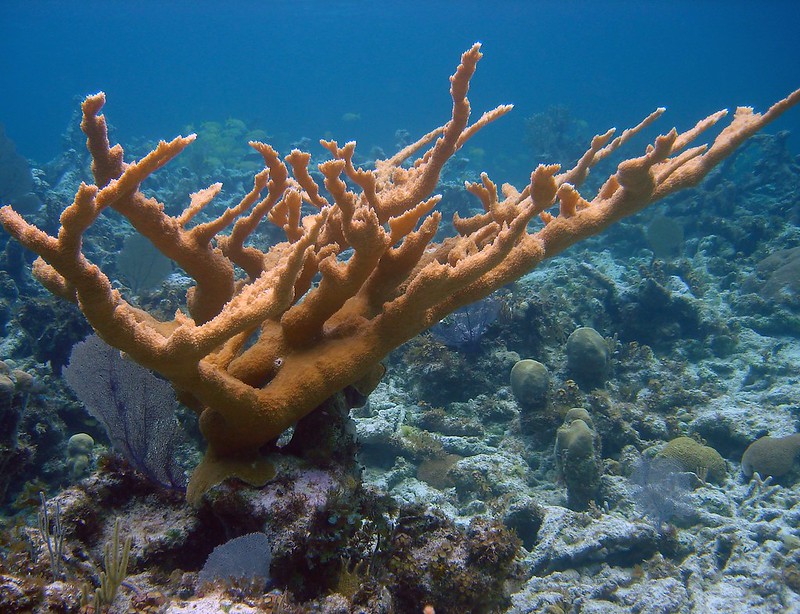
Elkhorn Coral Facts
- This highly distinctive invertebrate most frequently goes by the descriptive common name of Elkhorn Coral due to its unique appearance. Somewhat surprisingly, perhaps, this marvel of Nature and evolution does not currently have another broadly accepted general title.
- Within the scientific community, however, the wonder does have another designation by which it’s perhaps better known. Fortunately, that’s a comparatively simple term for the layperson to pronounce. That’s true since it holds the technical appellation of Acropora palmata.
- The impressive creature received that moniker due to the efforts of Jean-Baptiste Lamarck. The noted French naturalist accomplished the first recognition of the animal as a separate and distinct species. He managed to achieve that scientifically noteworthy feat in the year 1816.
- Sadly, the Elkhorn Coral now finds itself in dire straits. That’s true since its population base has been significantly reduced. That unfortunate state also extends across the entirety of its range. The IUCN therefore now lists the animal as Critically Endangered on its published Red List.
- It faces multiple threats to its continuation as a species. Like most forms of life on the planet today, the vast majority of these dangers stem from the actions of mankind. They now include such perils as habitat degradation and loss, and the ongoing effects of climate change.
Related Articles
Elkhorn Coral Physical Description
The fabulous Elkhorn Coral possesses an appearance that typically garners it a great deal of notice and appreciation by most individuals who encounter it. The amazing invertebrate manages to accomplish this feat due to a combination of both unique form and impressive physical dimensions.
Like some of its kindred, each specimen of this species develops numerous branches that display a frond-like structure. In shape, each of these sections further range in shape from flattened to nearly round. These also generally prutrude from the creature’s central trunk, and grow strongly upward.
When an individual’s fully mature, the branches of this marvel of Nature attain widths measuring up to 15 in (38.1 cm). The thickness of these varies accordingly, of course, yet reaches up to roughly 2 in (5.1 cm). That depth varies across the entirety of the branch, though, creating a rough appearance.
Due to its colonial nature, each example of this amazing creature possesses the ability to achieve significant sizes. Some, in fact, reach as much as 6 ft (1.83 m) in height, while managing to grow to a width that measures up to 12 ft (3.7 m). Few among the species manage to attain such size, though.
Understandably, it’s the overall design of the marvelous Elkhorn Coral that provides its common name, however. That’s because the general design closely resembles the antlers of an elk or similar relative. In color, these constructs range from various shades of pale brown to a light tan.
Yet, exceptional individuals of the fascinating animal nevertheless do occasionally occur. In fact, some individual colonies of this extraordinary Cnidaria attain widths measuring up to 43 ft (13.1 m). Examples of such size occur increasing infrequently, though, due to environmental conditions.
- Kingdom: Animalia
- Phylum: Cnidaria
- Class: Hexacorallia
- Order: Scleractinia
- Family: Acroporidae
- Genus: Acropora
- Species: A. palmata
Elkhorn Coral Distribution, Habitat, and Ecology
The intrepid Elkhorn Coral evolved as indigenous to a moderately small expanse of the marine regions of the globe. The exact nature and location of this zone of habitation stands out in the minds of many, though. That’s true since it lives in a specific portion of the Atlantic Ocean.
Yet, within this overall territorial range, the creature only inhabits narrow sections of the greater area. These mainly consists of the section known as the Caribbean Sea. It also makes appearances in waters off the Bahamas, and as far north as the shores of Florida, part of the United States.
Like many of its numerous relatives across the globe, this animal developed decidedly strong and clear preferences regarding its choice of habitat type. Not surprisingly at all, however, this ancient evolutionary requirement consists almost exclusively of regions composed of larger coral reefs.
The marine animal also needs extremely shallow waters. This typically therefore generally places its habitat quite close to the shore. It rarely appears at depths greater than 15 ft (4.6 m). Some, in fact, can be found near the shoreline, in waters measuring no more than 1 ft (0.3 m) in depth!
The captivating Elkhorn Coral actually acquires the great majority of its nutrition from sunlight. It does this, however, via the actions of photosynthetic algae that lives inside its cells. Yet, it still augments this with quantities of zooplankton, which it consumes via a process called filter feeding.
The animal also evolved as completely hermaphroditic in nature, with each individual being both male and female. Self-fertilization rarely happens, though. Reproduction only occurs once per year, under extremely specific conditions. This follows a full moon, in either July, August, or September.
Species Sharing Its Range
Check out our other articles on 3 Surprising South American Moths, Marbled Polecat, Lake Atitlan, Indian Bullfrog, Sicilian Fir, Tiger Shark, East African Lowland Honey Bee, Jamaican Iguana
